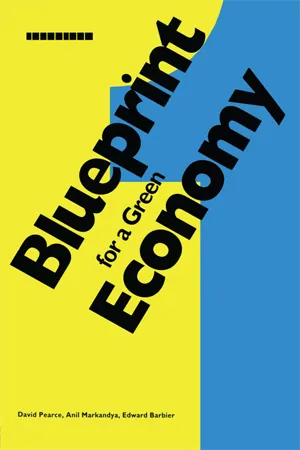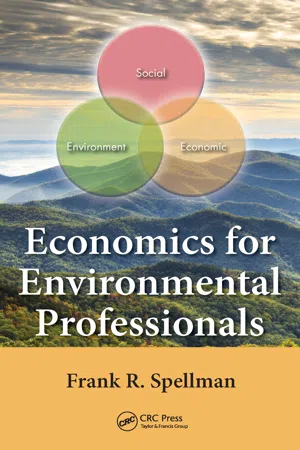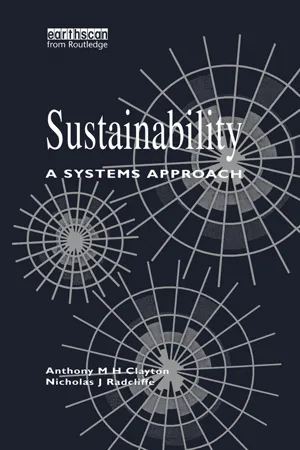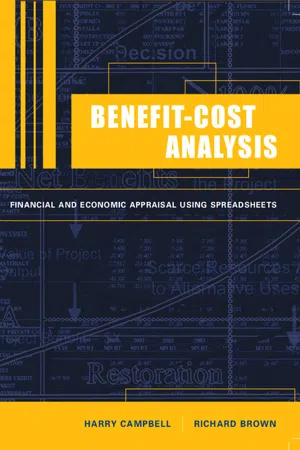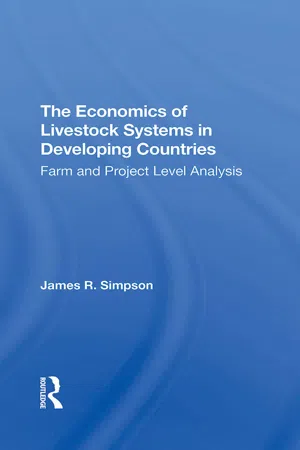Economics
Discounting
Discounting is a financial concept used to calculate the present value of future cash flows. It involves adjusting the value of future payments to reflect the time value of money, as money received sooner is worth more than the same amount received later. Discounting is commonly used in investment appraisal, bond pricing, and determining the value of long-term projects.
Written by Perlego with AI-assistance
Related key terms
1 of 5
12 Key excerpts on "Discounting"
- eBook - ePub
- Craig Langston(Author)
- 2008(Publication Date)
- Routledge(Publisher)
There is great institutional convenience in the uniform adoption of a standard form of appraisal; it seems to offer consistency, even if only in the form of consistent error. Compromises have been sought that modify Discounting incrementally so that its long-term effects are less severe. But most agree that Discounting is so firmly entrenched that it cannot readily be displaced, even if such action was considered appropriate(Price, 1993). 20.2 The rationale for Discounting Discounting is defined as the means by which equivalent value is determined. Costs and benefits that arise in different time periods must be brought to a common base so that a proper comparison can be made. This comparison concerns not just the timing of cash inflows and outflows for a given project, but the relationship of cash flows across projects. Therefore Discounting is a decision-aiding technique that enables alternative investments to be evaluated and ranked. Discounting processes result in the calculation of ‘equivalent’ values that are useful in comparing alternative solutions involving cash flows that span over more than one year. Discounted value is an ‘abstract’ measure that negates the need to explicitly consider finance costs while simultaneously allowing for the timing of cash flows. Ashworth (1999) warns that we need to remind ourselves consistently that we are comparing the worth of alternative systems and not their costs. Robinson (1986, pp. 18-19) confirms that in the context of life-costs: The problem areas generally arise as such because potential users of the technique are misled by the idea that the life cycle cost outcome must stand by itself in absolute terms. A little thought will lead to the conclusion that this is not possible. The life cycle cost outcome is only useful as a comparative figure for the purpose of ranking one solution over another - eBook - ePub
Blueprint 1
For a Green Economy
- David Pearce, Anil Markandya, Edward Barbier(Authors)
- 2013(Publication Date)
- Routledge(Publisher)
6 Discounting the FutureDOI: 10.4324/9781315070223-6The nature of Discounting
Chapter 1 explained that economic analysis tends to proceed on the basis that “economic value” reflects people’s preferences. Those preferences exhibit themselves in market and non-market situations, and there is no rational basis for designing economic policy as if only some preferences mattered, i.e. those expressed in the market place.But individuals also express preferences about when benefits and costs are desired. Typically, the later a cost or benefit occurs, the less it matters. The implicit weighting of the present over the future is known as Discounting and the rate at which the weight changes is the discount rate. Simple rationales for Discounting are as follows.Suppose that you are offered £1 now or you can wait for that £1 until next year. Assume for the moment that you are certain to be alive next year and the availability of the £1 next year is guaranteed. Will you wait or will you prefer to have the £1 now? Since the sum is the same, any preference exhibited for taking the money now is an instance of Discounting. Typically, people will take the money now. Why? There are several reasons.(i) With the £1, capital can be purchased, which can then be put to productive use. The existence of such productive opportunities means that in a year’s time the capital plus what it has generated will be worth more than £1, say £1.10. Effectively, then the choice becomes one of accepting £1 now or £1.10 next year. In the economist’s language, there is positive capital productivity. So, the first reason for Discounting is capital productivity.(ii) Even if capital investment was not productive in the sense outlined above people would still probably prefer the £1 now rather than next year. This is because people are impatient, or, to use the economist’s language, they have time preference - eBook - PDF
- Frank R. Spellman(Author)
- 2015(Publication Date)
- CRC Press(Publisher)
94 Economics for Environmental Professionals consumption—that is, given two identical rewards, humans typically show a prefer-ence for the one delivered sooner rather later—and that invested capital is productive and provides greater consumption in the future. Properly applied, Discounting can tell us how much future benefits and costs are worth today. Note: Discounting is the methodology used for identifying the present value of a cost or benefit that occurs at some time in the future. The process of Discounting is used to make costs or benefits that occur at different points in time commensurate with each other. Social Discounting , the type of Discounting discussed in this section, is discount-ing from the broad society-as-a-whole point of view that is embodied in cost–benefit analysis. Private Discounting , on the other hand, is Discounting from the specific, limited perspective of private individuals or firms. Implementing this distinction can be complex but it is an important distinction to maintain because using a given pri-vate discount rate instead of a social discount rate can bias results as part of a CBA. This section addresses Discounting over the relatively short term, what has become known as intragenerational Discounting , as well as Discounting over much longer time horizons, or intergenerational Discounting . Intragenerational, or con-ventional , Discounting applies to contexts that may have decades-long time frames, but do not explicitly confront impacts on unborn generations that may be beyond the private planning horizon of the current ones. Intergenerational Discounting, by contrast, addresses extremely long time horizons and the impacts and preferences of generations to come. To some extent, this distinction is a convenience as there is no discrete point at which one moves from one context to another; however, the relative importance of various issues can change as the time horizon lengthens. - eBook - PDF
- Kumar, K Nirmal Ravi(Authors)
- 2021(Publication Date)
- Daya Publishing House(Publisher)
This concept of present value is of central importance in economic analysis. We know that, benefits and costs from long term investments (projects) may not accrue immediately, but rather over a period of time. Since a dollar received today is worth more than a dollar received in the future, future streams of costs and benefits must be reduced to a present-day value. The difference between present and future dollar values is dependent upon the interest or discount rate. For example, the higher the interest rate, the more a dollar will return in the future, if loaned with interest. This logic can also be reversed so that, if future costs and benefits are known, and the interest rate is given, their present value can be calculated by the process of Discounting. The concept of Discounting is exemplified through Table 2.31. It is clear that, with increase in discount factor, the Present Worth of Costs (PWC) in a project will decline. Since, no Discounting is followed, the undiscounted cost structure lie parallel to the X-axis i.e., remains same for the entire life of the project (Figure 2.41). From the above discussion, it is clear that, ‘i’ refers to interest (discount) rate, (1+i) refers to compounding factor and 1/(1+i) refers to Discounting factor. Table 2.31: Relation between Discount Factor and Present Worth Discount Rate In the above example, we have discounted Rs.200 to its present value of This ebook is exclusively for this university only. Cannot be resold/distributed. Rs.181.40, when the rate of interest is 5 percent. This 5 percent interest that we have used to find the present value is called the Discount rate. This employment of discount factor to estimate the future value of present cash fl-ows (Compounding) and present value of future cash flows (Discounting) is a common practice in appraising long term investment decisions. Note that, the basic formula for Discounting can be applied regardless of the length of the time horizon. - eBook - PDF
A Course in Environmental Economics
Theory, Policy, and Practice
- Daniel J. Phaneuf, Till Requate(Authors)
- 2016(Publication Date)
- Cambridge University Press(Publisher)
The problem is even more acute when the issue is one of Discounting the distant future as, for example, is the case for evaluating the costs and benefits of climate change policy. The issues of uncertain 21 Cost-Benefit Analysis: Modeling 651 651 future interest rates and conceptualizing intergenerational transfers become important in this context. All of these issues – pragmatic estimation of costs and benefits, selecting discount rates, dealing with uncertainties, applying CBA – fall under the rubric of the practice of environmental economics. In this chapter we begin our discussion by examining modeling topics. Specifically, in the next section we present a theoretical examination of discount rates, which allows us to highlight an active area of research aimed at identifying which discount rate is appropriate for use in integrated assessment modeling of climate change policy. Fol-lowing this, in section 21.2 , we discuss integrated assessment modeling as a tool for comparing costs and benefits of environmental policies. Though a full consideration of integrated assessment models (IAMs) is beyond the scope of this book, our sense is that some familiarity with their workings is useful for applied environmental economists, and so we devote a section to the theme. We close the chapter with our usual summary and suggestions for further reading. 21.1 Discounting Discounting future costs and benefits is fundamentally related to how an individual or society is willing to trade off consumption in the present versus consumption in the future. In the stylized example above, we used the interest rate as an intuitive start-ing point for understanding this trade-off by an individual. Here we take a step back, and initially consider the willingness to engage in inter-temporal consumption swaps apart from the interest rate. The goal is to understand the structural determinants of the discount rate by looking at first principles. - eBook - ePub
Sustainability
A Systems Approach
- Tony Clayton, Nicholas Radcliffe(Authors)
- 2018(Publication Date)
- Routledge(Publisher)
Investment options are usually compared in terms of the revenues that each investment is expected to provide. The general principle of Discounting is that future revenues are discounted because they are assumed to be less valuable than current revenues. This, of course, tends to favour investments that offer greater short-term returns and militate against long-term investment.One of the most important reasons for Discounting is the existence of net productivity and interest rates. Capital invested today, at interest, will earn a profit. If the capital does not become available until tomorrow, then today’s potential profit is lost. This is why high interest rates generally covary with high discount rates.Discounting is also used for various other reasons. One factor is time preference. Under prevailing circumstances, people generally prefer to have returns on investment sooner rather than later. This is for a number of reasons:❑ People are impatient.❑ A given sum of money generally makes more of a difference to someone who is poor than someone who is rich. A trivial sum to a billionaire might seem like great wealth to someone on welfare. If an individual or a society is becoming or expects to become wealthier, therefore, it is reasonable to suppose that a given sum will make less of a difference to them in the future than it would today. Thus people prefer to have their returns sooner rather than later, as they anticipate that the later income will be worth less to them. This is termed the diminishing marginal utility of income.❑ There is a risk to the investor that he or she might die before a longterm investment matures.Clearly, there are a number of factors which make time preference entirely rational behaviour, and which tend to shorten the acceptable duration of an investment period. For example, conditions of extreme poverty oblige the sacrifice of long-term interests in order to secure short-term survival. Similarly, time preference tends to become more acute in times of social and economic uncertainty, as one cannot assume that any long-term investment will be safe. - eBook - PDF
- Kumar, K Nirmal Ravi(Authors)
- 2021(Publication Date)
- Daya Publishing House(Publisher)
Further, Opportunity Cost of Capital (OCC) is not taken into consideration (OCC refers to, what rate of return can the firm earns if that money was used elsewhere). So, this technique is considered less realistic compared to discounted technique. Further, these undiscounted measures will not take into consideration the timing of cash inflows into the project. Hence, the concept of ‘Discounting’ of net cash inflows or Discounting of costs and Discounting of benefits separately gives the right picture for analyzing the economic viability of project investment and for ranking of different project investments even of different durations. B. Discounting Technique In this technique, we take time value of money into consideration, unlike in UnDiscounting technique. Before going into the details of Discounting technique, let us discuss about the time value of money. There is a popular phrase that, ‘ A dollar today is worth more than a dollar a year from now ’. The same concept applies in choosing between investment projects. Those projects that promise earlier returns are more preferred to those that promise late returns. That means, a dollar received now is more valuable than a dollar received a year from now, because of the simple reason that, if you have a dollar today, you can put it in the bank and can have more than a dollar a year from now due to earning interest. In general, people prefer benefits or cash now to benefits or cash later for reasons which include: They desire to consume goods now rather than delay in their enjoyment They can invest the cash now in other lucrative opportunities i.e ., say on other enterprises or simply save the money in the bank The expectation of future benefits may have various risks and uncertainties Inflation will reduce the value of future benefits. - eBook - PDF
Management Science
Decision-making through systems thinking
- Hans Daellenbach, Donald McNickle, Shane Dye(Authors)
- 2017(Publication Date)
- Red Globe Press(Publisher)
Discounting of costs for public projects often raises serious ethical questions of equity between generations. Bluntly put, Discounting implies that future generations do not count. The interested reader should consult the relevant discussion in Mishan (1981). Activity Why is it advisable/essential that normal commercial ventures be evaluated on the basis of their discounted cash flows, while Discounting of costs and benefits of projects that involve safety, health, or environmental issues raises serious moral and ethical questions? 10.5 Spreadsheet financial functions Spreadsheets have built-in financial functions that perform most Discounting compu-tations with a few easy key strokes. They allow the user to specify the timing of each cash flow — end of period or beginning of period — with end-of-period timing usually being the default. The four financial functions which you will need most often are the following (the forms shown in Figure 10-3 is for Excel; they are similar for other spreadsheet packages; the major difference may be the sequence of the function arguments): Net present value of a stream of cash flows: NPV( r , Xi:Yj), where [Xi:Yj] indicates the first and last in a row or column of cells containing the sequence of cash flows, occurring at the end of consecutive periods. The initial cash flow at the beginning of the first period (period 0) may have to be added as a separate undiscounted entry. Present value of an annuity: PV( r , number of periods, annuity, fv, type), where the annuity is the constant payment per period, ‘fv’ and ‘type’ are optional arguments with a default value of zero. If type = 0, then the annuity is assumed to occur at the end of each period, i.e., post-paid, if type = 1, then the annuity is assumed to occur at the beginning of each period, i.e., prepaid. (For Excel, this function assumes that the annuity is a cash outflow, hence it returns a negative value if the annuity is listed as positive.) - eBook - PDF
Philosophy and the Precautionary Principle
Science, Evidence, and Environmental Policy
- Daniel Steel(Author)
- 2014(Publication Date)
- Cambridge University Press(Publisher)
chapter 6 Counting the future Imagine finding out that you, having just reached your twenty-first birthday, must soon die of cancer because one evening Cleopatra wanted an extra helping of dessert. Tyler Cowen and Derek Parfit, “Against the Social Discount Rate,” p. 145 6.1 How to count the future? Decisions about long-term problems inevitably raise questions about how the interests of the present should be balanced against those of the future. Should present and future generations be treated impartially, or should present concerns be weighted more heavily than later ones? In economics, this topic is discussed under the heading of Discounting. Whether one chooses to discount the future, and at what rate, can obviously have an enormous impact on policy decisions regarding environmental issues that play out over a period of decades or, in some cases, centuries. Moreover, dis- counting is highly relevant to PP, as precautions typically involve incurring some present cost or inconvenience for the sake of mitigating some future risk. In this chapter, then, I examine the relationship between Discounting and PP. Debates on Discounting are often divided into two main approaches, descriptive and prescriptive (Arrow 1999; Frisch 2013; Nordhaus 2007). According to the descriptive approach, the future should be discounted by a factor that reflects the rate of return on investment, which is regarded as an indicator of the extent to which people actually discount the future in comparison to the present. The descriptive approach seems to be motivated by the anti-paternalistic conviction that it is not the job of economics to tell people what values they should have. Instead, the thought is that the role of economic advice is to assist people in making decisions that are rational given their preferences. Consequently, if people systematically discount the 120 - eBook - PDF
Benefit-Cost Analysis
Financial and Economic Appraisal using Spreadsheets
- Harry F. Campbell, Richard P. C. Brown(Authors)
- 2003(Publication Date)
- Cambridge University Press(Publisher)
Discounting of utility may simply be an expression of tastes, but it may also reflect the fact that the future is uncertain. It will be recalled that one approach to dealing with risk in investment appraisal discussed in Chapter 2 involved adding a risk premium to the discount rate. By adding a risk premium reflecting the probability of the net benefit stream ceasing in any given year, the analyst is able to calculate the expected net present value of the project. Individuals face some probability each year that their utility stream will terminate due to death. In developed economies this probability is quite low: the probability of a middle-aged person dying in the forthcoming year is around one percent. An individual who used this rate to discount future utility in making decisions about present vs . future consumption would, in effect, simply be using her expected total undiscounted utility as a basis for evaluating alternatives. The second reason for Discounting future consumption is the expectation of being wealthier in the future because of economic growth. As noted in the discussion of risk in Chapter 9, it is generally assumed that an individual’s utility rises at a decreasing rate as their wealth increases. Diminishing marginal utility reflects the fact that each extra dollar of wealth contributes less to increasing utility as the amount of wealth increases. An individual consid-ering saving, as opposed to spending, an extra dollar has to compare the extra utility which saving that dollar (and using the interest and principal to increase spending in the future) will yield as compared to the extra utility from spending it now. If wealth is expected to be higher in the future, the marginal utility obtained in the future from spending a dollar will be less than the marginal utility obtained from spending it now. - eBook - PDF
The Economics Of Livestock Systems In Developing Countries
Farm And Project Level Analysis
- James R Simpson(Author)
- 2019(Publication Date)
- CRC Press(Publisher)
This concept is known as the time value of money. As an example, assume that $1.00 is invested at 12 percent interest compounded annually for 10 years. The investor would receive $3.11 at the end of that period. Discounting is basically the reverse of com-pounding because the objective is to bring a future stream of benefits or costs back to the present. The parallel question from the compounding example is: what would $3.11 received 10 years from now be worth today given an opportunity cost of capital (the amount that could be received on money invested) of 12 percent. The answer is $1.00. 178 Formula Classification There are a whole host of financial problems involving the time value of money. Some of the computations are time consuming and tedious if done by hand, but with the advent of low-cost pocket calculators and microcomputers containing programs for financial problems, the computa-tions are now relatively easy. The more difficult part is to categorize the alternatives and to determine the appropriate formula for each problem. A classification of the formulas is given in Figure 9.1 in an effort to overcome the confusion resulting from the myriad special cases. The classification is divided into two types of payments according to whether they are costs or income. A second breakdown is frequency of payments, either one time or recurring. Recurring payments are further subdivided into two categories, ones with the same amount at regular intervals and ones with varying amounts at irregular intervals. A final classification is the relationship of the conversion period to the payment period. The formulas, shown at the bottom of the figure, are divided into two types: those referring to future value (with a positive n) and the ones for present value computations (with a negative n). The positive n indicates a discount process. Discounting results in a smaller sum, while com-pounding results in a larger sum. - eBook - ePub
Fundamentals of Investment Appraisal
An Illustration based on a Case Study
- Martina Röhrich(Author)
- 2014(Publication Date)
- De Gruyter Oldenbourg(Publisher)
3 Discounting Methods ofInvestment Appraisal
3.1 Learning Objectives
In the previous chapter, we examined non-Discounting methods of investment appraisal. The intention of this chapter is to provide an overview of the Discounting methods of investment appraisal. Upon its completion the reader will be able to- – understand what the main Discounting methods of investment appraisal are;
- – apply the financial mathematics involved in the discounted cash flow techniques and
- – gain an insight into the advantages and disadvantages of each presented method.
Furthermore, the comparison of alternatives and the replacement decision are presented as major problems of investment decisions. Salvage values at the end of the estimated life of the asset no longer require a separate section because by the Discounting methods of investment appraisal they are treated like normal cash inflows. Exercises and answers will deepen and consolidate the understanding of the Discounting methods of investment appraisal.3.2 Time Value of Money
3.2.1 Basic Example
To start with, we refer to an easy example. Consider a firm that wants to buy a new car. Table 3-1 describes the alternatives to assess:Table 3-1 Basic example of the time value of moneyVehicle A Vehicle B Initital outlay in € 10,000 15,000 Anticipated average life in years 5 5 Interest rate in % 5 5 Maintenance and repair in € per year 1,250 125 To identify the differences between the non-Discounting and Discounting methods of investment appraisal in Table 3-2 we begin again by applying the cost comparison method:Table 3-2 Cost comparison for the basic exampleVehicle A Vehicle B Depreciation 2,000 3,000 Imputed interest 250 375 Maintenance and repair 1,250 125 Total costs 3,500 3,500 The cost comparison method does not lead to a correct decision because the average total costs per year are equal. If we additionally assume that both alternatives yield average annual receipts of € 5,000 and afterwards run the profit method, then again both alternatives are ranked the same. The annual average accounting profit is € 1,500 for vehicle A as well as for vehicle B.
Index pages curate the most relevant extracts from our library of academic textbooks. They’ve been created using an in-house natural language model (NLM), each adding context and meaning to key research topics.

